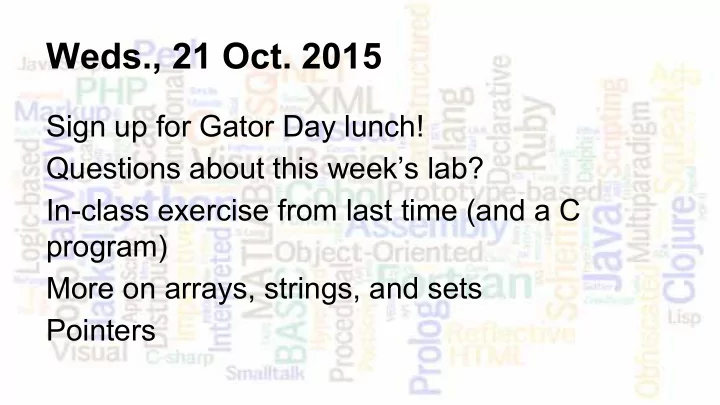

Weds., 21 Oct. 2015 Sign up for Gator Day lunch! Questions about this week’s lab? In-class exercise from last time (and a C program) More on arrays, strings, and sets Pointers
Exercise from Last Time int a[3][4][2][5]; ? Come up with a formula for the address of a[i][j][k] [l] , assuming zero-based indexing, assuming that each array element is 4 bytes and that row-major ordering is used, and, of course, assuming that i,j,k, and l are within the array bounds. See exercise.c in oct21 folder of repository. Same, but for column-major ordering.
Other Aspects of Arrays--Bounds If arrays are just consecutive locations in memory, how does the computer know whether, e.g, an array is 3 by 4 or 4 by 3 or 2 by 6 or …? It needs to remember this information somewhere--symbol table (static arrays) or “dope vector” (dynamic arrays)--see page 331. Checking for out-of-bounds indices at runtime affects security (see sidebar, p. 353).
Dynamic Arrays In C, array size is known at compile time unless we allocate memory from the heap and use pointers to access it. See program “ array6.c ” in the oct21 folder for an example using “ malloc ”.
Changing Array Shape We can exploit the linear storage of arrays to view the array contents as if it has different “shapes” -- see programs “ array3.c ” and “ array4.c ” in the oct21 folder of the repository. NOTE: In C we can’t actually change the declared shape, but we can “get around” this using pointers (see section 7.7).
Arrays of Arrays Consider the C or Java declaration: int a[3][4]; This can be considered as an “array of arrays”: an array a[3] whose elements are of type “int [4]”. Once we allow this, we can allow more general “arrays of arrays”, e.g., Array5.java
Sets (Quick Skim!) You may have encountered “Set”-like classes in Java; e.g., program Sets.java shows the HashSet class. Some language have a built-in “set” data type. Python: >>> s = {1,2,4,5,1,2,3,5,3,2,1} >>> s set([1, 2, 3, 4, 5])
Sets (Quick Skim!) It is relatively easy to implement “small sets” in a programming language (usually max of 32 or 64 elements). See, e.g., program set.c in the oct21 repository. The idea is to use the bits in an int or long to stand for elements, then use bit operations | and & for union and intersection.
Pointers We’ve already seen examples of pointers in C. Since C is often used by systems programmers, it is convenient to be able to directly access and manipulate memory addresses. However, care must be taken. How many of you have ever seen the words: segmentation fault
Recommend
More recommend